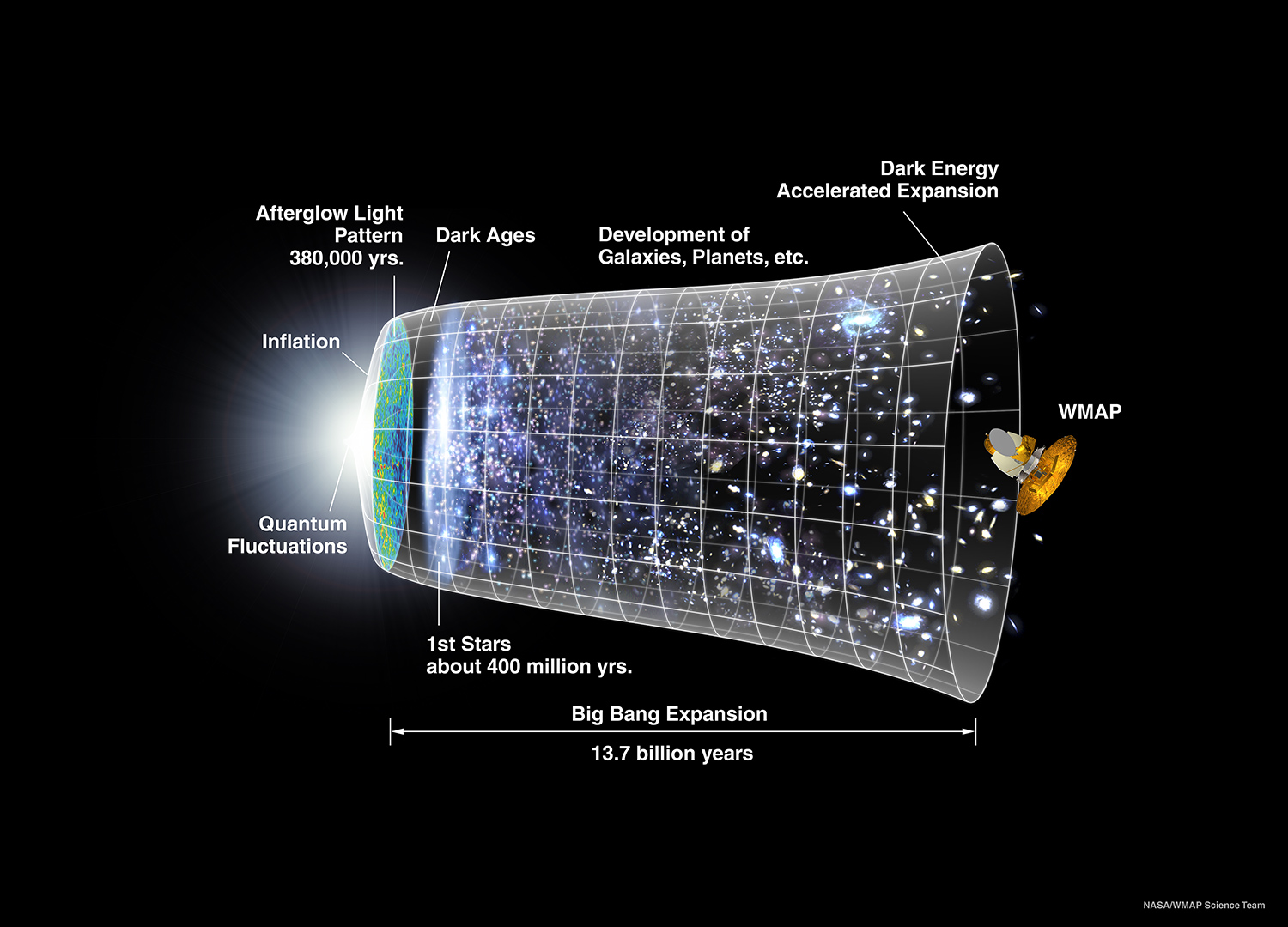Modeling the Cosmological Past
About 14 billion years ago, the Universe began expanding in all directions from an infinitesimally small, infinitely dense point known as a singularity. This event is known as the
Big Bang.

- This illustration presents a timeline for the creation and expansion of the universe based on direct observations and the standard cosmological model.
- Photo Credit: WMAP Science Team
Within the first few seconds following the onset of the rapid inflation, and lasting for the next hundred thousand years, the fundamental particles that would later comprise matter came into being but matter as we know it did not yet exist. During this period, the Universe was opaque, filled with intensely hot plasma and powerful radiation.
However, as the expansion of the Universe continued, its temperature and density gradually decreased. Plasma and radiation was eventually replaced by hydrogen and helium, the simplest, lightest and most abundant elements in the Universe.. Gravity required several hundred million additional years to coalesce these free-floating atoms into the primordial gas out of which the first stars and galaxies emerged.
This explanation about the beginning of time was derived from the
standard model of big bang cosmology, also known as the
Lambda Cold Dark Matter cosmological model of the Universe or simply as the
Lambda CDM. A cosmological model is a mathematical description of the Universe that attempts to explain its current behavior and evolution over time. Cosmological models are based on direct observations. They are capable of making predictions that can be validated by subsequent investigations and rely on general relativity because that theory produces the best agreement with large-scale behaviors that have been observed. Cosmological models are also rooted in two fundamental assumptions:

- In 1995, astronomers using the Hubble telescope solved a 20-year-old mystery by showing a class of galaxies once thought to be rare is actually the most common type of galaxy in the universe.
Analyzing some of the deepest images ever taken of the heavens, the astronomers concluded that small irregular objects called "blue dwarfs" were far more numerous several billion years ago, outnumbering giant elliptical galaxies and spiral galaxies like our Milky Way.
- Photo credit: R. Windhorst and S. Driver (Arizona State Univ.), B. Keel (Univ. of Alabama), NASA HubbleSite
- The Earth is not located at the center of the Universe nor does it occupy a special place therefore the Cosmos looks the same in all directions and from every location on a grand scale and
- the same laws of physics which operate on Earth also function throughout the Universe regardless of time.
Therefore, what we observe today can be used to explain past, present or help predict future events in nature no matter how remote the phenomenon is located.
Incredibly, the farther we peer out into the heavens, the farther we gaze back into the past. This allows us to conduct a general survey of galaxies when they were much younger so we can better understand how they evolved to those that are closer, and therefore much older. Of course, we cannot see the same galaxies at different stages in their development. But we can have a good idea by grouping galaxies into categories based on what we observe.
Since the first galaxies are believed to have formed from gas clouds shortly following the beginning of the Universe, the standard big bang model expects we will find the earliest galaxies filled with young, hot stars that will give these early star systems a blue hue. The model also predicts the first galaxies were more numerous and much smaller than those of the present day and that star systems grew to their current size
hierarchically as the small galaxies merged and formed larger island universes over time.
Interesting, many of these predictions have been validated. For example, as early as 1995 when the Hubble Space Telescope first looked deep toward the beginning of time, it found the young Universe was filled with faint blue galaxies that were thirty to fifty times smaller than our Milky Way.
The standard big bang model also predicts these mergers are still continuing therefore we should find evidence of this activity in neighboring galaxies, too. Unfortunately until recently, there has been little evidence of merger activity among galaxies near the Milky Way. This has been a problem with the standard big bang model because it suggested our understanding of the Universe might be incomplete or flawed.
More
»